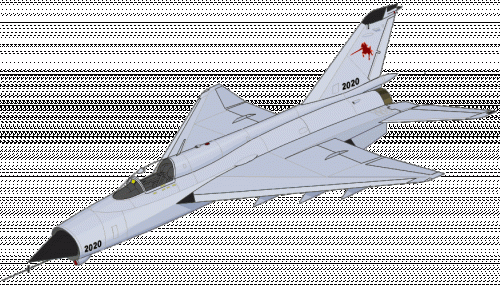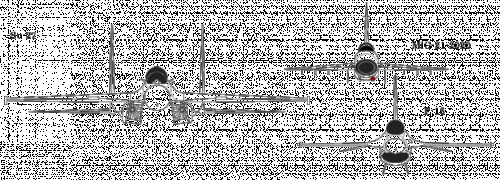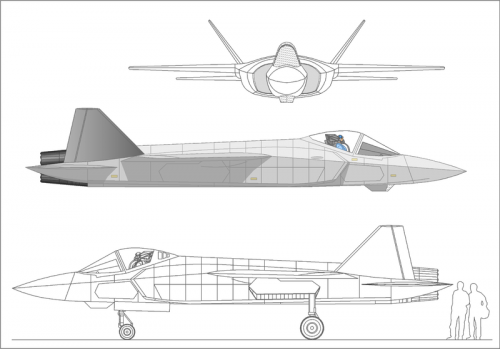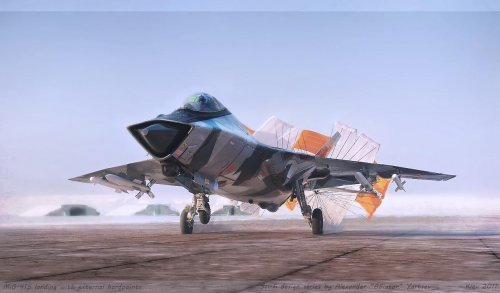Russian aircraft manufacturer RSK-MiG seems to be quietly at work developing a new, lightweight fighter concept that could be a single-engine, lower-tier complement to the Sukhoi T-50/PAK-FA fighter currently in developmental flight testing.
Discussions about this MiG project have been around for some time, but speculation about the programme's status was raised by an announcement at the end of December that the single, flying prototype of the MiG 1.44 fifth-generation Multirole Fighter (MFI) project will be put in "conservation storage at a hangar located at the Gromov Flight Research Institute [LII]", according to an official statement by MiG. Up to this point the aircraft had made only two flights, both of which were in 2000, and has been utilised since as a working model to support the development of the T-50 programme.
The decision is considered to be of some significance since the order was to keep the aircraft in long-term storage rather than to have it cannibalised for parts and its valuable components recycled. The latter course was ordered by the Ministry of Defence (MoD) to be carried out on the first Tupolev Tu-160 prototype, which was the Soviet Union's very first supersonic strategic bomber capable of carrying nuclear weapons.
"This is a curious choice," according some Russian aerospace analysts, "to spare the MFI prototype and junk the Tu-160 since the Russian programme for a next-generation bomber, the PAK-DA, is further along in concept development and has more support behind it from the MoD and the Russian Air Force [VVS] than a new, single-engine fighter."
Keeping the MFI intact for now may be an indicator that there is a desire within some corners of the MoD and VVS to keep MiG designers working on some kind of next-generation fighter "in case the T-50 cannot be built in sufficient numbers or falls significantly behind schedule", said one Russian aerospace specialist.
RSK-MiG representatives have thus far refused to comment on whether or not there are any future plans for the one assembled MFI prototype, as well as for the four unfinished airframes from the programme that are located at the Sokol aircraft plant in Nizhni-Novgorod.
However, within the VVS and RSK-MiG's parent company, United Aircraft Corporation (UAC), "the idea of another next-generation fighter programme running in development is not universally liked", according to one Moscow-based Russian defence policy analyst. "The T-50 is going to end up costing more than was originally planned, and it is going to take longer to complete - as all of these programmes do - so [Sukhoi and UAC CEO Mikhail] Pogosyan wishes everyone would stop any talk about a new lightweight fighter project."
Advocates of the project defend the concept by stating that it would be a low-cost effort because it would utilise a good deal of existing technology; it would be powered, for example, by a single Klimov/Sarkisov RD-33 jet engine - the same powerplant already used on the MiG-29.
At present the project is still a "paper aeroplane: existing only in drawings", said the Russian aircraft industry specialist, "and there is no outside funding for this programme. For now it remains a pure internally budgeted design study."
Russia's industry lacks a small, affordable fighter that it could sell to those nations unable to afford an export variant of the T-50; countries that in the past operated MiG-21s or the various Chinese-made copies of that aircraft. However, there is also sentiment expressed by those in Russia who spoke to IHS Jane's that a new fighter of this type could be repeating the scenario of the Sukhoi Superjet regional airliner: spending a lot of money for very mediocre returns in an attempt to copy something that already exists in the current aircraft market and could have just been licence-assembled in Russia for far less (which in the case of the Superjet would be the Embraer E-jet series).
"When I discussed this programme with some people I knew were working on it, I told them that this aircraft they are trying to create and build in Russia already exists and is already flying in several countries," said the Russian aircraft industry specialist. "It's called the Gripen."
Like the US Air Force, the Russian (and in prior years, Soviet) armed forces have maintained a 'high/low' mix of a heavy, twin-engined fighter as an air superiority and interceptor aircraft with a lighter, smaller fighter to complement it. In order to maintain that kind of force structure the upper half of the fighter fleet would become the T-50 and some aircraft would then have to replace the lower end, which is currently occupied by the MiG-29, just as the Lockheed Martin F-35 is supposed to replace the F-16 in later years.






